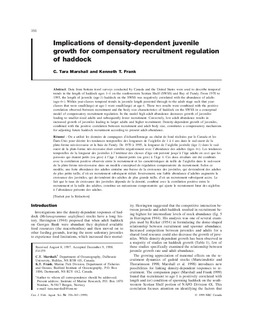| dc.description.abstract | Data from bottom trawl surveys conducted by Canada and the United States were used to describe temporal
trends in the length of haddock ages 1–4 on the southwestern Scotian Shelf (SWSS) and Bay of Fundy. From 1970 to
1995, the length of juvenile (age-1) haddock on the SWSS was negatively correlated with the abundance of adults
(age-4+). Within year-classes temporal trends in juvenile length persisted through to the adult stage such that yearclasses
that were small(large) at age-1 were small(large) at age-4. These two results were combined with the positive
correlation observed between recruitment and the body size characteristics of haddock on the SWSS in a conceptual
model of compensatory recruitment regulation. In the model high adult abundance decreases growth of juveniles
leading to smaller-sized adults and subsequently lower recruitment. Conversely, low adult abundance results in
increased growth of juveniles leading to larger adults and higher recruitment. Density-dependent growth of juveniles,
combined with the positive correlation between recruitment and adult body size, constitutes a compensatory mechanism
for adjusting future haddock recruitment according to present adult abundance. | en |
